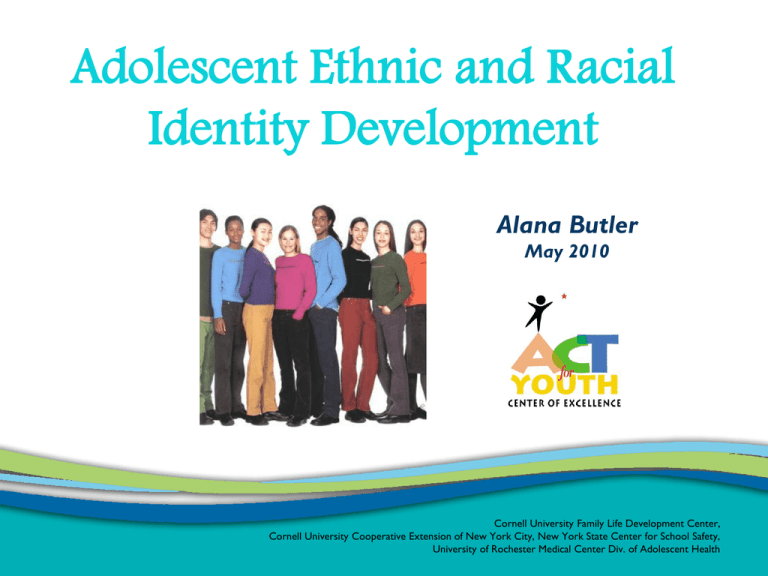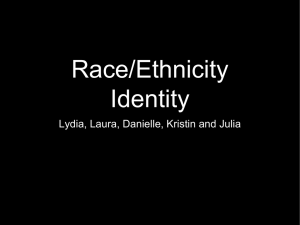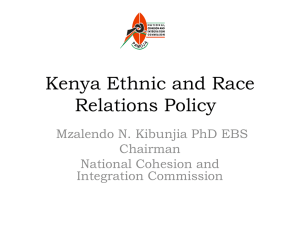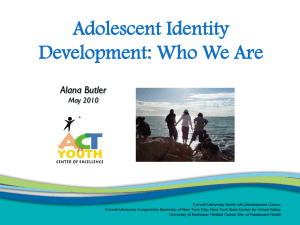Adolescent Ethnic and Racial Identity Development
advertisement

Adolescent Ethnic and Racial Identity Development Alana Butler May 2010 Cornell University Family Life Development Center, Cornell University Cooperative Extension of New York City, New York State Center for School Safety, University of Rochester Medical Center Div. of Adolescent Health Learning Objectives Define ethnic and racial identity. Identify the stages/statuses in racial and ethnic identity development. Recognize the importance of racial and ethnic identity development for youth. Adolescent Ethnic and Racial Identity Development Alana Butler ● May 2010 What is Ethnicity? Ethnic group members share national ancestry and also one of the following: culture religion race language place of origin Adolescent Ethnic and Racial Identity Development Alana Butler ● May 2010 What is Race ? Socially defined category for individuals who have certain common physical traits. Ideas about defining race have changed over time. Members of the same racial group can have different ethnicities. Adolescent Ethnic and Racial Identity Development Alana Butler ● May 2010 What is Racial and Ethnic Identity? Sense of belonging to a particular race or ethnicity. Feelings of identifying with one’s group, sharing commitment and common values. Adolescent Ethnic and Racial Identity Development Alana Butler ● May 2010 Stages in Ethnic Identity Development Phinney’s three stages in ethnic identity development occur anytime between the ages of 12 and 18. Adolescent Ethnic and Racial Identity Development Alana Butler ● May 2010 Stages in Ethnic Identity Development Unexamined Moratorium Achieved Racial Identity Development Dr. William Cross: status model. Now used to explore racial identity development for all racial groups. Adolescent Ethnic and Racial Identity Development Alana Butler ● May 2010 Status One: Pre-Encounter Not yet consciously aware of race and its effects. Scenario Until age 12, Kevin grew up in a diverse neighborhood and never thought of himself as African-American. Adolescent Ethnic and Racial Identity Development Alana Butler ● May 2010 Status Two: Encounter An encounter causes one to evaluate the role of racial identification in one’s life. Upon entering high school at age 14, Kevin is forced to think about his race for the first time because of an encounter with racism. Adolescent Ethnic and Racial Identity Development Alana Butler ● May 2010 Status Three: Immersion Exploration of one’s own race. From ages 14 to 16, Kevin begins to learn about African-American history and becomes friends with his African-American peers. Adolescent Ethnic and Racial Identity Development Alana Butler ● May 2010 Status Four: Internalization and Commitment The individual now internalizes the meaning of their race and commits to particular racial identification. By age 16, Kevin is now committed to his African-American identity and includes this as a key part of his identity. Adolescent Ethnic and Racial Identity Development Alana Butler ● May 2010 Ethnic Identity and Self-Esteem In Phinney studies, positive sense of ethnic identity scored higher than all other groups on measures of psychological adjustment. Adolescent Ethnic and Racial Identity Development Alana Butler ● May 2010 Our Identities In conclusion: We each have ethnic and racial identities that may not only be different but may also confer privilege. There are statuses in racial and ethnic identity development that change over time. Racial and ethnic identity is a very important aspect for our self-esteem. Adolescent Ethnic and Racial Identity Development Alana Butler ● May 2010 Was this presentation useful? Please give us your feedback: http://www.zoomerang.com/Survey/WEB22AEZWMYJH3 The ACT for Youth Center of Excellence connects positive youth development resources and research to practice in New York State and beyond. The Center provides: Technical support, training, and evaluation for youth-serving programs funded by the NYS Department of Health. Youth Development resources: www.actforyouth.net, publications, training and events, and the e-letter ACT for Youth Update. Email act4youth@cornell.edu to subscribe. A home base for the ACT Youth Network. Visit the network at www.nysyouth.net ACT for Youth Center of Excellence act4youth@cornell.edu • 607-255-7736 • http://www.actforyouth.net Resources Understanding Race http://www.understandingrace.org/home.html Race: Power of an illusion http://www.pbs.org/race/000_General/000_00-Home.htm Ethnic identity and youth http://www.lsic.ucla.edu/classes/psych/mays/phinney.html Adolescent Ethnic and Racial Identity Development Alana Butler ● May 2010 ACT for Youth Center of Excellence act4youth@cornell.edu • 607-255-7736 • http://www.actforyouth.net








